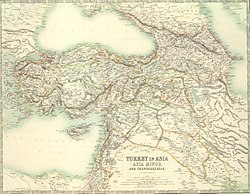Karasid dynasty

The Karasids or Karasid dynasty (Ottoman Turkish: قرا صي; Turkish: Karesioğulları Beyliği), also known as the Principality of Karasi and Beylik of Karasi (Karasi Beyliği or Karesi Beyliği ), was an Anatolian beylik in the area of classical Mysia (modern Balıkesir and Çanakkale provinces) from ca. 1297–1345. It was centered in Balıkesir and Bergama, and was one of the frontier principalities established by Oghuz Turks after the decline of the Seljuk Sultanate of Rum.
They became a naval power in the Aegean and the Dardanelles.
Rulers
[edit]| Bey | Reign | Notes |
|---|---|---|
| Kalem Bey | 1297-1303 | |
Interregnum
| ||
| Karesi Bey | 1307-1328 | |
| Aclan Bey | 1328 | |
| Yahşi Han | 1328-1345 | |
| Demirhan Bey | 1345-1351 | |
| Süleyman Bey | 1351-1361 | |
History
[edit]Karasi's father Kalam (referred to as Calames by Gregoras) was the son of Yaghdi Bey. The epitaphs of members of the Karasi family in Tokat, Kutlu Melek and his son Mustafa Chelebi, tie their ancestry to the Danishmendids, a dynasty who ruled over northeastern Anatolia during the 11–12th centuries.[1] Modern historian Claude Cahen holds that the homonymy between the central Anatolian family and the dynasty in northwestern Anatolia may not be a sufficient evidence for a connection.[2]
Ottoman sources referred to Karasi as a nöker (vassal) during the first reign of Mesud II (r. 1284–97, 1303–8), the Sultan of Rum. Kalam and Karasi Bey are thought to have taken over the region around Balıkesir during Mesud's reign and claimed independence at an unknown date.[1] Fifteenth century Byzantine Greek historian Doukas wrote that they appeared in the region during the rule of the Byzantine Emperor Andronikos II (r. 1282–1328).[2] It corresponded to the ancient region of Mysia, excluding the towns of Artaki, Pegae, Adramytion, Pergamon, and Dardanellia.[1] However, Cahen proposes that the state appeared much later as medieval writers Ramon Muntaner and George Pachymeres do not mention the Karasids. Cahen disputes historian Mordtmann's connection of the Lamisai mentioned by Pachymeres and the Calames (Karasi's father Kalam) of Nicephorus Gregoras.[2]

The Byzantines tried to incite beyliks like Karasids against the Ottomans. However, routes of conquest and other objectives of beyliks such as Karasids did not initially conflict with the Ottomans. The political situation clearly favored the Ottomans.[3]
| History of Turkey |
|---|
 |
| Timeline |
|
|
See also
[edit]References
[edit]- ^ a b c Günal 2001, p. 487.
- ^ a b c Cahen & de Planhol 1978.
- ^ Mehmet Fuat Köprülü (1992). The Origins of the Ottoman Empire. SUNY Press. p. 112. ISBN 978-0-7914-0819-3.
Bibliography
[edit]- Clifford E. Bosworth, The New Islamic Dynasties, 1996. s.v. The Qarasï (Karasï) Oghullarï", p. 219.
- Cahen, Claude & de Planhol, Xavier (1978). "Ḳarasi̊". In van Donzel, E.; Lewis, B.; Pellat, Ch. & Bosworth, C. E. (eds.). The Encyclopaedia of Islam, Second Edition. Volume IV: Iran–Kha. Leiden: E. J. Brill. OCLC 758278456.
- Günal, Zerrin (2001). "Karesi Bey". TDV Encyclopedia of Islam, Vol. 24 (Kāânî-i Şîrâzî – Kastamonu) (in Turkish). Istanbul: Turkiye Diyanet Foundation, Centre for Islamic Studies. pp. 487–488. ISBN 978-975-389-451-7.
- Halil Inalcik, The Ottoman Empire - The Classical Age, 1300-1600[1]
